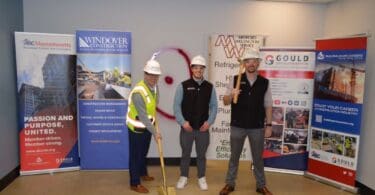On today’s college campuses, sustainable design is normative. Higher ed institutions have long stood at the forefront of the sustainable design movement, and at many schools LEED Certification of new facilities has evolved from design option to expectation.
Heading into 2011, this shift is inspiring new thinking about campus facilities projects. LEED Certification typically remains a goal, but colleges and universities increasingly measure project success by more than a LEED scorecard, and teams are adopting different design approaches as a result.
Healthy Buildings for Healthful Living
Just a few years ago, green buildings were known more for energy performance than creature comforts: the dorm had the LEED rating, but the neighboring fitness center was the campus hotspot. That gap is closing. With many New England institutions now pursuing a campus-wide vision for healthy living and sustainability, facilities are growing more supportive of both community and environmental wellness. Lifestyle amenities are increasingly incorporated into green building programs, enhanced by “traditional” sustainable design approaches like natural materials, better ventilation, and maximum daylighting. As a result, students are increasingly gravitating to these buildings not only because they’re green, but because they’re welcoming and attractive.
The change is visible on campuses across Massachusetts. At Northeastern University’s new International Village Dining Hall, fresh, nourishing global cuisine and a welcoming interior environment go hand in hand with LEED Gold sustainable design. At Worcester State University, the new Dowden Hall incorporates retail space, a wellness center, and new student activity areas within a LEED Gold level building powered by renewable energy systems. Two very different institutions, both embody the trend of sustainable design promoting a healthy campus identity.
Integrated Design/Engineering Approaches
As sustainable design visions have heightened, so have the expectations for designers. In the past, architects routinely hired outside consultants to sift through LEED administration and advise on emerging technologies. Now, design firms increasingly handle LEED administration in house, and top teams combine sustainable architectural knowledge with deep understanding of renewable power systems. The result is a more integrated design attitude: the ability to efficiently achieve LEED Certification in the short term, and to address prescriptive efficiency requirements and new codes while maximizing performance over the long haul.
The Massachusetts State College Building Authority (MSCBA) is a case in point. In 2006, this agency selected my firm, PCA Inc., to design a sustainable expansion to campus housing at the Massachusetts Maritime Academy. LEED Certification wasn’t an initial goal, but was added to the program, and PCA subsequently hired an outside consultant to ensure Certification. Just two years later, MSCBA partnered with us again on a residence hall expansion, but their expectations had become markedly more sophisticated. LEED Silver level design was a project prerequisite, and the Authority requested both LEED administration services and recommendations for renewable energy systems. An integrated design approach was crucial to meeting the challenge.
“Provable” energy-savings.
MSCBA’s evolution reflects another growing reality: the balance sheet matters more than the LEED scoresheet. Top sustainable facilities translate LEED “points” into measurable dollar savings. To to this, designers must harness a wide range of expertise, identifying not only best fit renewable energy systems and sustainable design approaches, but also new incentives such as utility rebates for efficient electric lighting, motors, and mechanical plants. The combination will differ on every building project, but the trend is clear. Tangible returns on green investment are no longer aspirations, they are becoming requirements, and project teams must be prepared to deliver.
Taken collectively, these trends are great news. As the economy stalled, sustainable design thinking and technology only continued to proliferate. As we leave the recession behind and university building projects increase, campuses stand to reap the benefits: beautiful facilities that provide not only better energy savings, but a better quality of life.
Steve Allen, AIA, LEED AP is a Principal at Prellwitz Chilinski Associates Inc.


